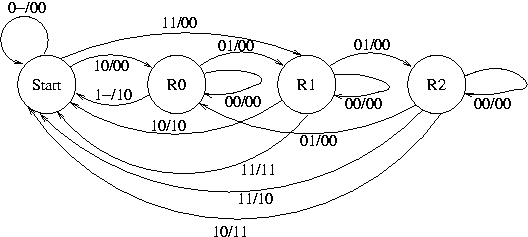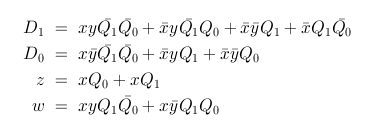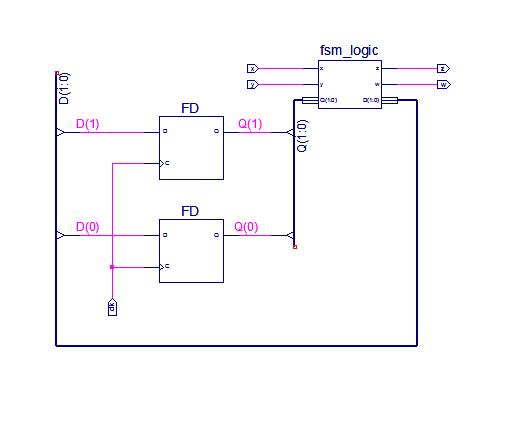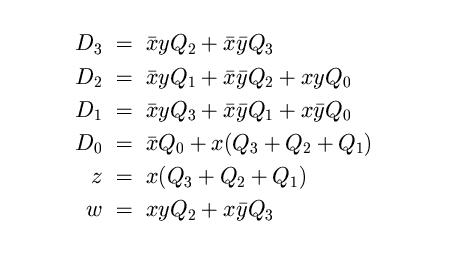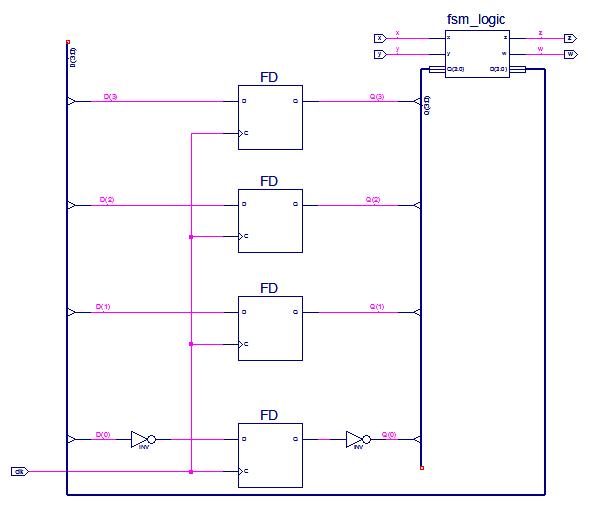Difference between revisions of "Implementing State Machines using Verilog for the logic"
| Line 3: | Line 3: | ||
To illustrate the process we will use a sequential circuit with two synchronous inputs x and y, and two outputs z and w. In this example the input x is a marker indicating the start and stop of a sequence of data bits which appear on input y. When x is high at the clock edge, the sequence starts with the current value on y and continues until the next clock edge where x is high. The output z should be high on the clock edge where the sequence stops: effectively, every other edge where x is high. The output w should be high at the same time as z but only if the number of 1's on the clock edges between the start and stop is 2 (modulo 3). | To illustrate the process we will use a sequential circuit with two synchronous inputs x and y, and two outputs z and w. In this example the input x is a marker indicating the start and stop of a sequence of data bits which appear on input y. When x is high at the clock edge, the sequence starts with the current value on y and continues until the next clock edge where x is high. The output z should be high on the clock edge where the sequence stops: effectively, every other edge where x is high. The output w should be high at the same time as z but only if the number of 1's on the clock edges between the start and stop is 2 (modulo 3). | ||
| − | [[File:fsm_ex. | + | [[File:fsm_ex.gif]] |
With the minimum length state encoding (Q1, Q0) below | With the minimum length state encoding (Q1, Q0) below | ||
Revision as of 21:57, 21 March 2011
This page decribes how to implement a state machine using a combination of schematics and Verilog for the next state and output logic.
To illustrate the process we will use a sequential circuit with two synchronous inputs x and y, and two outputs z and w. In this example the input x is a marker indicating the start and stop of a sequence of data bits which appear on input y. When x is high at the clock edge, the sequence starts with the current value on y and continues until the next clock edge where x is high. The output z should be high on the clock edge where the sequence stops: effectively, every other edge where x is high. The output w should be high at the same time as z but only if the number of 1's on the clock edges between the start and stop is 2 (modulo 3).
With the minimum length state encoding (Q1, Q0) below
State Q1 Q0 Start 0 0 R0 0 1 R1 1 0 R2 1 1
we came up with the following equations for the next state and outputs:
The Verilog code for this logic is:
module fsm_logic(x,y,Q,z,w,D); input x; input y; input [1:0] Q; output z; output w; output [1:0] D; assign D[1] = x&y&~Q[1]&~Q[0] | ~x&y&Q[0]&~Q[1] | ~x&~y&Q[1] | ~x&~Q[0]&Q[1]; assign D[0] = x&~y&~Q[1]&~Q[0] | ~x&y&Q[1] | ~x&~y&Q[0]; assign z = x&Q[0] | x&Q[1]; assign w = x&y&Q[1]&~Q[0] | x&~y&Q[1]&Q[0]; endmodule
The state machine is implemented in the schematic below by adding two flip-flops (FD) and including the symbol for the state machine logic. Since the encoding for our start state was Q1Q0=00, the global reset will put our machine into the Start state.
If instead we use one-hot encoding:
State Q3 Q2 Q1 Q0 Start 0 0 0 1 R0 0 0 1 0 R1 0 1 0 0 R2 1 0 0 0
we would obtain the following equations for the next state and outputs:
The Verilog code for this logic is:
module fsm_logic(x,y,Q,z,w,D); input x; input y; input [3:0] Q; output z; output w; output [3:0] D; assign D[3] = ~x&y&Q[2] | ~x&~y&Q[3]; assign D[2] = ~x&y&Q[1] | ~x&~y&Q[2] | x&y&Q[0]; assign D[1] = ~x&y&Q[3] | ~x&~y&Q[1] | x&~y&Q[0]; assign D[0] = ~x&Q[0] | x&(Q[3]|Q[2]|Q[1]); assign z = x & (Q[3]|Q[2]|Q[1]); assign w = x&y&Q[2] | x&~y&Q[3]; endmodule
The state machine is implemented in the schematic below by adding 4 flip-flops (FD) and including the symbol for the state machine logic. We would like the global reset to put our machine into the Start state (Q3Q2Q1Q0=0001). To make this happen we put inverters around the flip-flop holding Q0. The only effect this has is to make Q0 = 1 on reset.
